Only missing February and June this year – and we only have January because a xerox of it was stuck to the reverse side of a frame in Tom Brakefield’s Jean Blanchard archive of caricatures (posted last week).
January 1948
According to this January column, Warner’s submitted Buccaneer Bunny, Tweetie Pie, Hop Look and Listen and Scardy Cat for an Academy Award nomination. Only Tweety made the cut – and won!
Sorry I don’t have a larger version of this month’s column – you’ll have to squint like I did to read about Michael Maltese’s roach party – and much about Hawley Pratt…
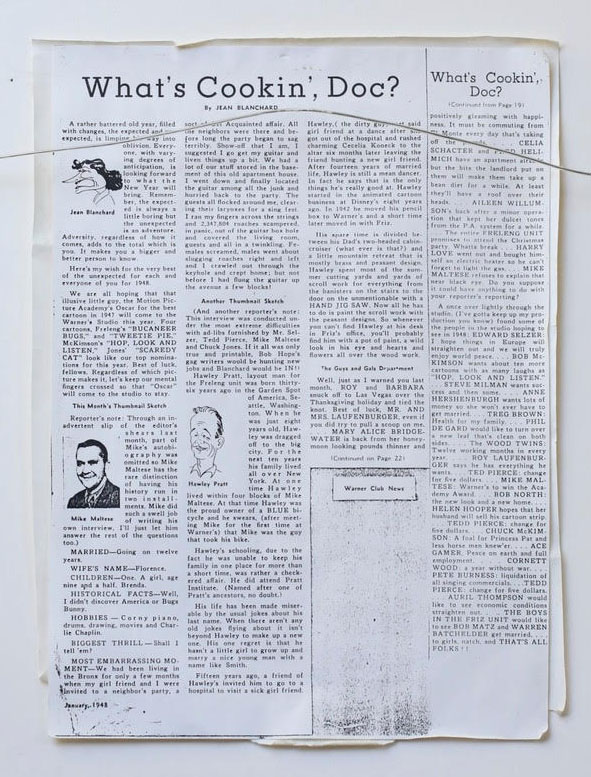
March 1948
Apparently Jean Blanchard left the studio to write a book – and Treg Brown takes over the chores for the rest of the year – on Mr. Selzer’s orders. Much about the background of Carl Stalling here – noting his first cartoon was Galloping Gaucho and tying together the Kansas City roots of Stalling, Freleng and Disney.
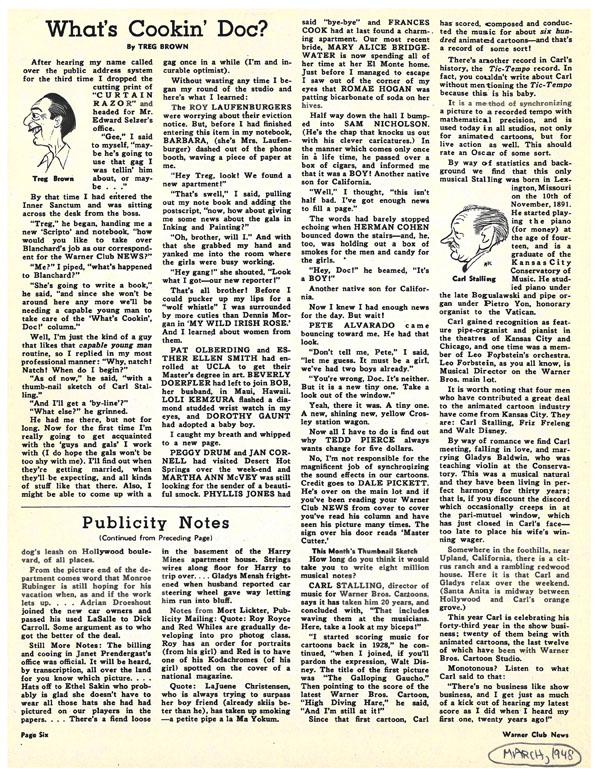
April 1948
Beyond the fantastic cover image the cartoon studio provided, this month Tedd waxes on about the joys of visiting the all-female ink and Paint department; and tells us of Gerry Chiniquy who went to Fairfax High School in Hollywood – and co-starred with Baby Peggy in silent films!
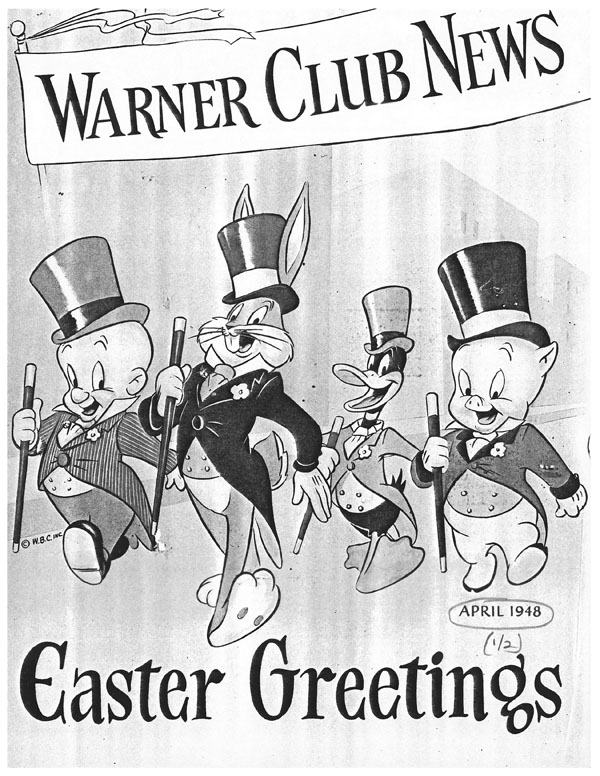
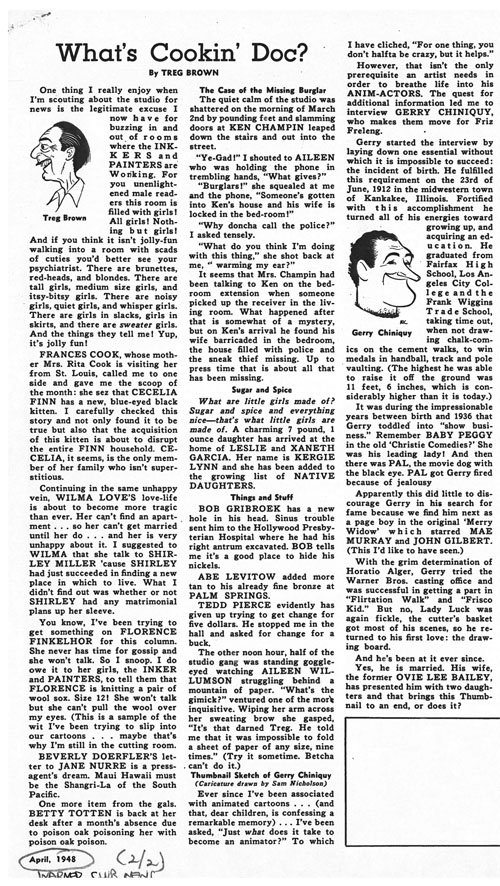
May 1948
Eddie Selzer receives the Oscar from Shirley Temple. Phil DeGaurd also has history with Baby Peggy; and here’s a name I hadn’t heard before: Florence Finkelhor, the head of the ink & paint department.
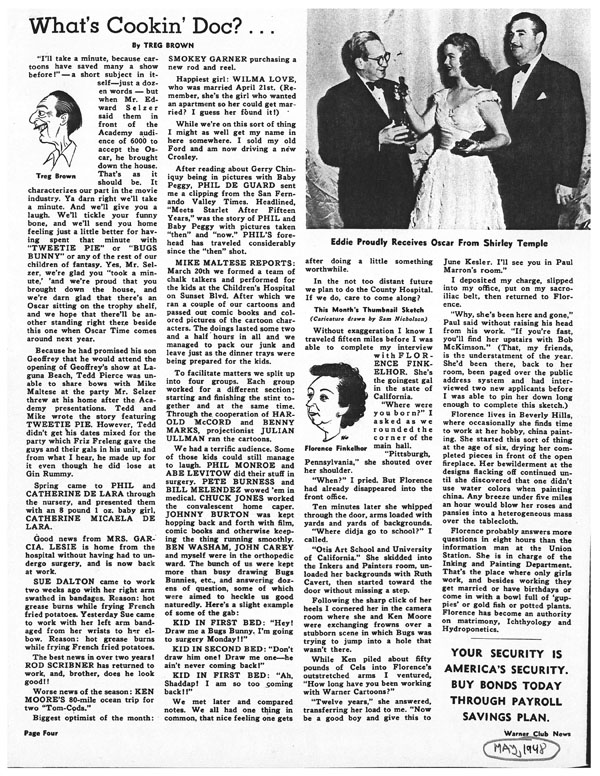
July 1948
Meet the Assistant Supervisor of the Ink and Paint Department: Ruth Cavert!

August 1948
Phil Monroe get a “thumbnail sketch” this month; and the Chuck Jones animators become the beach ball team from Pimento University!

September 1948
Much ado about Ed Selzer… among the nuggets: Selzer was supposed to start an animation department for Warner Bros. in 1930 – but that got derailed (could Selzer have had anything to do with Buster Bear?). Selzer was in charge of titles ands trailers for Warner Bros. (and all publicity) in the 1930s. Irv Spector flew in from New York to visit the Warner Studio and his old friends there… Maltese and Foster got advance copies of their Capitol Bugs Bunny records.
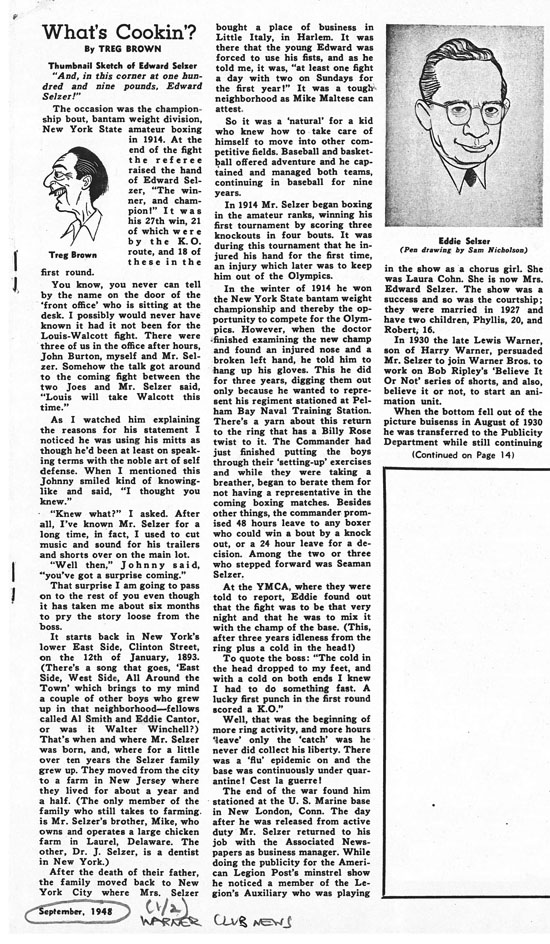
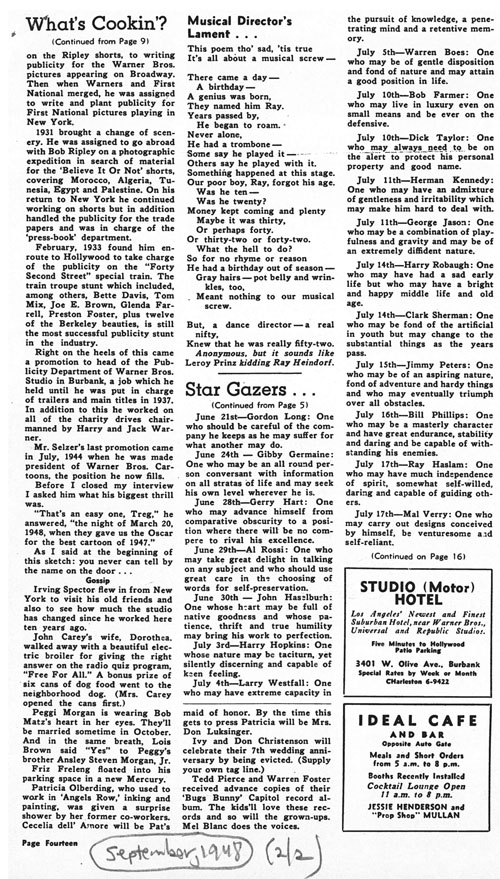
October 1948
All about cameraman Ken Moore, who started at Iwerks and did camera on Snow White before joining Warner Bros. And Linda Jones finds a note in a bottle.
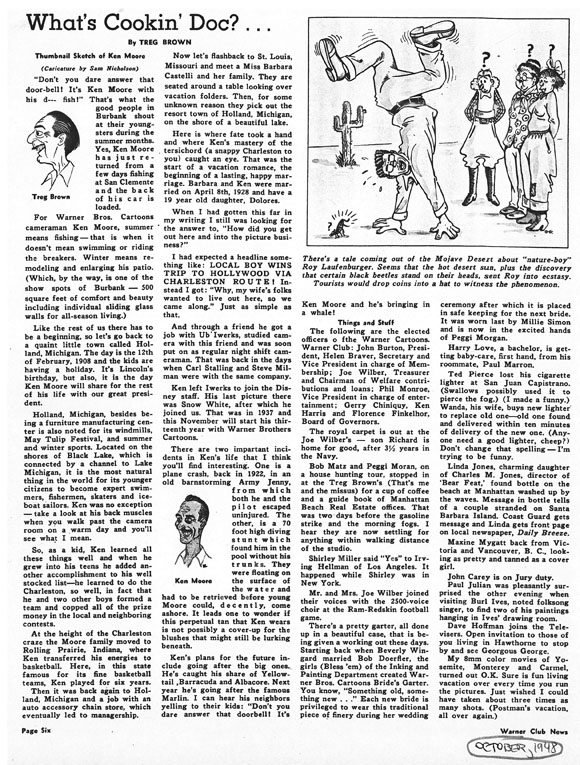
November 1948
All about Ed Selzer’s assistant Helen Braver.
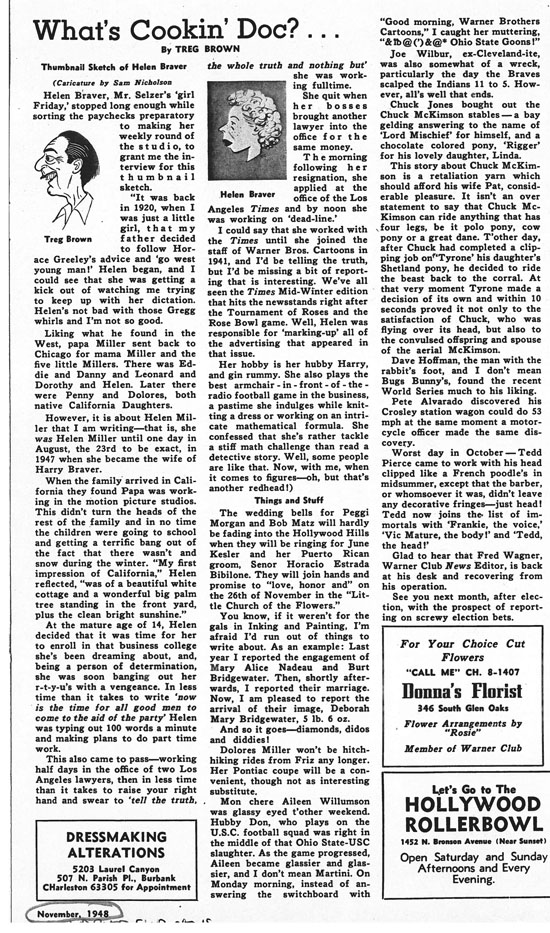
December 1948
All about inbetweener Jack Phillips. Ben Hardaway returns to the studio as a story man for Freleng. Most interesting is the notice of Alan Pakula joining the staff as John Burton’s assistant. Pakula would later go onto greater success and fame as producer of To Kill A Mockingbird (1962) and later the director of such big films as All The President’s Men (1976) and Sophie’s Choice (1982)!
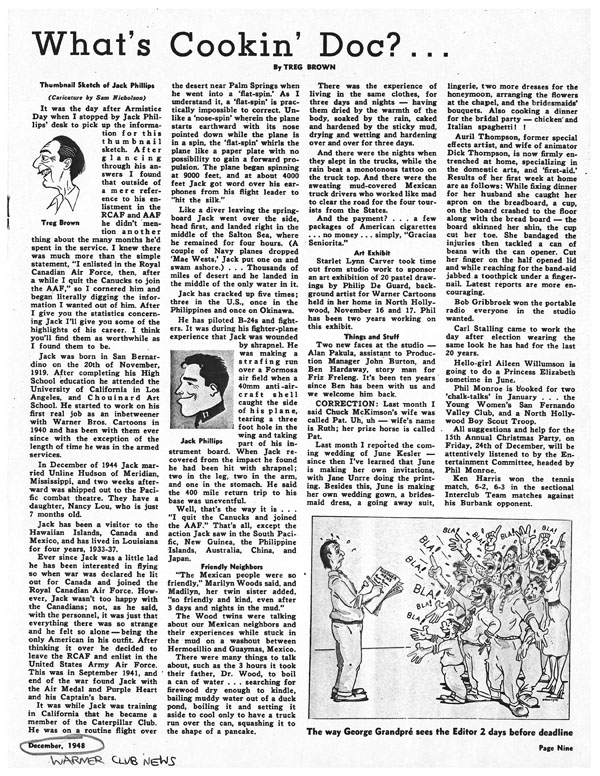


 Jerry Beck is a writer, animation producer, college professor and author of more than 15 books on animation history. He is a former studio exec with Nickelodeon Movies and Disney, and has written for The Hollywood Reporter and Variety. He has curated cartoons for DVD and Blu-ray compilations and has lent his expertise to dozens of bonus documentaries and audio commentaries on such. Beck is currently on the faculty of CalArts in Valencia, UCLA in Westwood and Woodbury University in Burbank – teaching animation history. More about Jerry Beck [
Jerry Beck is a writer, animation producer, college professor and author of more than 15 books on animation history. He is a former studio exec with Nickelodeon Movies and Disney, and has written for The Hollywood Reporter and Variety. He has curated cartoons for DVD and Blu-ray compilations and has lent his expertise to dozens of bonus documentaries and audio commentaries on such. Beck is currently on the faculty of CalArts in Valencia, UCLA in Westwood and Woodbury University in Burbank – teaching animation history. More about Jerry Beck [



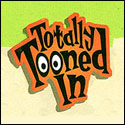



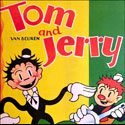
Oh, do I wish I could read and see these posts. Each time you folks mention BUSTER BEAR, the more I wish that a good print of that cartoon actually existed somewhere to be used possibly as a special feature on some upcoming LOONEY TUNES project…if there was one in the works.
Perhaps, where it best belongs would be as special feature on something like LOONEY TUNES, THE EARLY YEARS, focusing on the Harman/Ising and mid-1930’s transition period cartoons with BUDDY, BEANS, HAM AND X and without any continuing characters. You know how I feel about the 1930’s. Here’s hoping that more on the BUSTER BEAR cartoon can be found, and with reasonably good sound, if this is actually a sound film!
It is also fascinating to note how many well-known names began somewhere in the animation industry. If there are actually enough names in that area, perhaps this should be the subject of a future post. I wonder if there are more folks like Frank Tashlin out there who worked in animation *AND* went on to equal fame in the live action film biz.
A good print (scratch that, a GREAT print) of BUSTER BEAR does exist… it is indeed a sound film… and it will be included in a future video release. It’s not going to be a Looney Tunes collection, but a video collection nonetheless. Stay tuned for more details.
I (as many others are) am THOROUGHLY enjoying these posts with so much WARNER history. It’s especially great that it comes from inside the studio as opposed to being written ‘about’ the studio. Thanks Jerry! …DJA
So is it safe to presume the Lantz studio was closed in December 1948 and Hardaway came over? Or did he leave before it shut down and left the remaining story work to Heck Allen? Did someone leave Warners to make room for him?
I’m pretty sure there’s a reference to Florence Finklehor in “Chuck Amuck.”
It seems we now know who the “NIC” is that signed those caricatures posted last month.
I wonder if Virgil Ross drew that cover.
Looking at the caricature of Jean Blanchard, you’d never guess she did the late ’40s model of Bugs for the McKimson unit: pudgy, eyes too small, nose too big, lower lip too prominent, rather disagreeable-looking.
Because of his dispute with Universal (and his studio’s cartoons briefly released through United Artists during that period), Lantz decided to temporarily shut down his studio by early 1949, and started to lay off some of his staff at the end of ’48…including Hardaway. He didn’t resume production again until 1951.
(The Hardaway file at the Harry Truman Presidential Library has a copy of a resume that he filled out when looking for a government job — Hardaway had served under Truman in World War I, and knew him very well — and Hardaway’s second tenure at WB is mentioned. I think the resume dates from the early 50s.)
Interesting to know what Warners submitted for academy consideration this year. It whets the appetite as to what the other studios submitted.